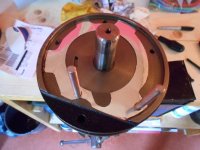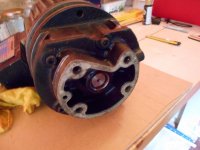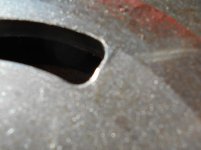Hi,
I've tried to add as much detail as possible during the restoration including my initial negative thoughts which I said would most likely swing to positive as work progressed? Well I can say I've finally succeeded in restoring this Hydrovane into full working order and I've now got a wide smile on my face.
The new service kit arrived as did the two large "O" rings and three oil seals. The oil seals were straightforward to install but a lot of care is needed to get them the correct way round; I bought a tube of Silicone Grease which was used both in the oil seal fitting then for packing the seals as suggested in the workshop manual; with two seals installed then comes a split aluminium spacer and the open split must align with an hole in the casting then the final seal can be installed.
I cleaned out the vane housing using clean cloth ensuring there was no gunge or debris left in there. I knew I would have trouble in the two vane shim gaskets one at each end of the vane stator; these measured 0.002" (two thou) each and are described as plastic in the workshop manual. I'm resourceful though and found our kitchen aluminium foil measured 0.001" which was the nearest material I had to hand which could possibly do the job? Firstly though I needed to accurately measure both the vane stator and rotor thicknesses as this is critical; the stator needs to be very slightly larger in thickness than the rotor. I had difficulty obtaining steady readings using my digital vernier calliper so resorted to my trusty micrometer; the stator was 1.456" thick whilst the rotor was 1.455". With the two original shim gaskets installed this would give a working clearance of 0.005".
I found using the foil as gasket material tested my patience and a few false starts were made ending up with balls of foil but with a bit of practice I became better; I was seated at the bench for comfort because this foil is extremely easy to ruin; I found by laying a piece of foil on the stator I could gently hold the foil in position with fingers of one hand whilst my other hand was used to press very gently allowing an outline to be added to the foil; using a sharp craft knife with the foil resting on flat card I then carefully cut around the outlines which in turn provided the gaskets I needed. Realizing how critical it is to obtain as close running clearance as possible I wondered if I could get away with just two of these thinner shim gaskets giving only 0.003" clearance? I assembled the motor and outer vane casting ensuring all mating surfaces were perfectly clean by going around with a safety razor as a scraper. The motor was then positioned upright in the woodworkers vice and two location long threaded rods added; one gasket was placed in position again taking a lot of care not to damage the gasket; the gasket was installed "dry" the vane stator was then gently lowered onto the gasket guided by the rods which went well but then as I tried to add the vane rotor the vanes started to slide out and it's important these vanes be kept in their original slots the correct way around?
I removed the motor from the vice and gently placed it on the clean bench; the motor shaft was rotated bringing the keyway to the top and the key was inserted; with the string still around the rotor I carefully pushed the rotor on to the motor shaft easing the string away as the rotor went home. This is a job were it doesn't pay to rush or be heavy handed; the second shim gasket was added as was the outer cover followed by the securing socket head screws; these screws were tightened evenly and I was very lucky because I found the motor shaft could be turned by hand; it was a bit stiff which I expected due to three new oil seals bearing down on it but I couldn't detect any metal to metal contact. I watched the rotor as I turned the shaft and noticed the vane blades were not dropping into contact with the stator? Was the running clearance too tight which was a worry? Rather than rip it all apart I decided to put some power into the motor to see if centrifugal force would have the desired result; I covered the vane housing with a towel and gave the motor a quick burst of power; this brought the blades into contact with the stator so I was well pleased. I had put plenty of oil on all the moving parts during assembly.
The motor flange/vane unit large diameter "O" rings were easier than expected to install; with the "O" rings in position they and the outer flange together with the vane housing were treated to a good coat of silicone grease; the motor/vane unit was pushed home up to the second "O" ring then it was drawn fully home using the two threaded rods ensuring the "O" rings did not become nipped or damaged; once the second "O" ring disappeared I knew I was then safe.
This was the most difficult part over and the rest of the assembly went very well indeed. New "O" rings were installed as required; two new filters were installed as was the new correct PTFE unloader valve seating washer; I used the new piston I had made and reassembled the unloader valve then installed it.
The oil was added then power applied; the air pressure rapidly rose to 110psi and remained there but is it going to remain there or once again creep into the red zone? An hour later the pressure was still at the 110psi although as I kept watching it I noticed it would creep upwards slightly then come back down much to my relief and pleasure. So at last the wayward air pressure has been tamed and the Hydrovane runs beautifully. After an hours test run I tried the blow gun to find it still puts out lots of water vapour but by your kind replies I now accept this and I think I'll be looking at installing a receiver tank and water trap but I'll give this some thought because now this Hydrovane is fully running as it should it will be worth more should I decide to sell it and invest in a newer up to date Hydrovane with the receiver already installed to save me more work?
I'd like to thank the moderators for allowing me to run this thread even though I'm now writing as a home workshop guy and for all you members for your input and most welcome suggestions. I've written in such a style hopefully which a novice can follow; initially I wanted advice about this Hydrovane 6PU because there was so little about it on the net; I've ended up doing the full rebuild whilst learning a great deal. I'm sure the new shim gaskets and the unloader valve piston will give trouble free service over the years and it shows what can be done with a little imagination in a home workshop at very little cost. I've enjoyed the learning curve and have a nice quiet compressor in my garage so I think it fair to say its been a success. There is now some Hydrovane 6PU information on the net for others to view
Kind regards, Col.
















 I was just so excited to get the Hydrovane running again it brought tears of joy to my eyes. Out of interest I've now bought an Apollo Pro-Spray 1500 paint spraying outfit to take care of my paint spraying needs; this cost £160 delivered bought second hand through eBay; it's previously been used for one job and is still very much like new at less than half price of a new one.
I was just so excited to get the Hydrovane running again it brought tears of joy to my eyes. Out of interest I've now bought an Apollo Pro-Spray 1500 paint spraying outfit to take care of my paint spraying needs; this cost £160 delivered bought second hand through eBay; it's previously been used for one job and is still very much like new at less than half price of a new one.